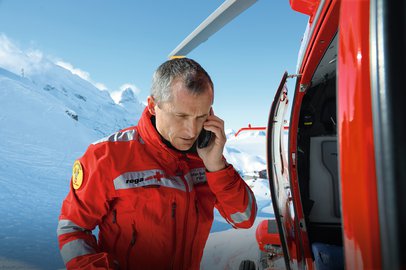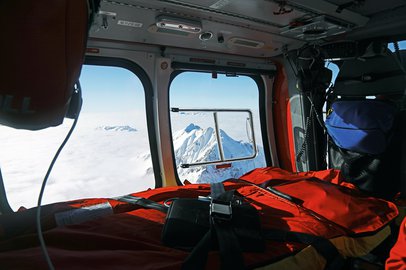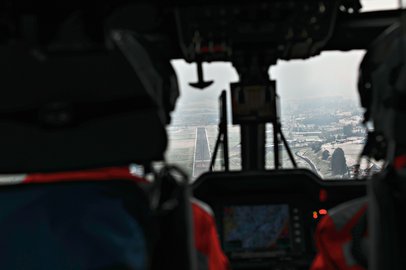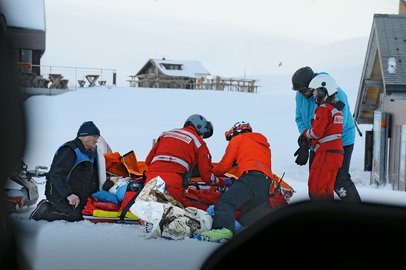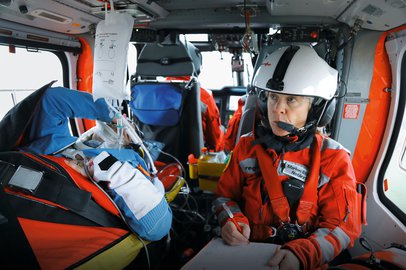The Reuss Valley in Uri is shrouded in low-lying cloud on this Sunday morning in February. Already at just under 200 vertical metres, the steep walls on the left and right of the valley floor disappear in the dense fog. From the bright blue sky that promises a beautiful winter’s day ahead, not a single ray of sunshine breaks through the fog cover to reach the Rega Erstfeld base at 402 metres above sea level. The TV in the recreation room at the helicopter base is showing slow panning shots from the weather cameras in the winter sports resorts. Everywhere the picture is the same: perfect winter sports conditions above an almost seamless sea of fog. So far, the slopes are still empty. The base of Rega 8 – the Uri crew’s radio call sign – is already a hive of activity. Immediately after the joint briefing with his colleagues, pilot Stefan Bucheli completed the daily check on the rescue helicopter. Meanwhile, paramedic Gery Bissig and emergency flight physician Marion Städler have checked the medical equipment – Rega 8 is ready for operation.
Blue above, grey below
Today’s fog poses a challenge for the crew. The skiers and snowboarders are above the fog, the hospitals below it. “Helicopters usually operate under visual flight rules and are prohibited from flying through a dense bank of fog for safety reasons – even on rescue missions,” Bucheli explains. “Thanks to what are known as ‘instrument flight rules’, however, we are able to pass through a blanket of cloud on a predefined flight route and approach the military airfield in Emmen, for example, even when visibility is at a minimum.” Outside the operating hours of the Emmen airfield, such as at the weekend, approaches are only permitted under instrument flight rules (IFR) and takeoff is prohibited. The IFR route is therefore only an option for transport to hospital. If the crew are to assist an injured person above the fog today, they will have to find a gap in it that will allow the helicopter an ascent under visual flight rules. On the computer, Bucheli carefully checks the data from the Rega weather stations and the live images from webcams at the various locations. That gives him an overview of the current weather situation and lets him see how far the sea of fog stretches. He is interrupted by a call from the Operations Centre over the radio on his desk: “Primary mission on Mt. Titlis, shoulder injury.” The scene of the accident is above the fog. Less than three minutes later, Rega 8 has taken off and is flying beneath the fog over Lake Uri towards Zug. The aim is to find a hole in the fog cover. On the webcam, the pilot had managed to make one out towards the Albis.
Lifted off the mountainside
A few minutes later, the crew find the gap they were looking for, and Rega 8 climbs beyond the clouds into the sunshine. The cockpit is flooded with light, and the imposing sea of fog stretches across the full north side of the Alps. The mountain peaks of Central Switzerland rise like islands out of the fog. The crew check again the coordinates that the Rega flight coordinator has sent directly to the tablet computer in the cockpit and study the additional information: an off-piste skier has suffered a fall away from the slopes and hurt his shoulder. At the accident scene, Rega flight physician Marion Städler is lowered on the rescue hoist to the injured man. While she is providing medical assistance, pilot Stefan Bucheli and paramedic Gery Bissig wait at a temporary landing site and discuss the next stages of the mission.
Instrument flight route through the fog
Their plan is to use the Emmen military airfield’s instrument flight approach to fly the patient to Nidwalden Cantonal Hospital below the fog. “Just a few months ago, that would not have been allowed on a Sunday. However, now that we have special authorisation from the Federal Office of Civil Aviation (FOCA), Rega can use the IFR approach at the weekend and during the night,” Bucheli explains. Over the radio, Rega physician Marion Städler reports that she has attended to the patient and prepared him to be transported by rescue hoist. Pilot Stefan Bucheli starts the engines and paramedic Gery Bissig gets ready at the open door for the rescue hoist operation. Moments later, the flight physician and the injured man are suspended beneath the helicopter on a 90-metre-long steel rope. At the temporary landing site, the casualty is transferred to the helicopter and the crew take off for Emmen. Over Central Switzerland, Bucheli switches to the instrument flight route. From this point on, the helicopter flies along the route using the ultraprecise autopilot – with Bucheli and Bissig checking that the parameters are maintained. As the helicopter slowly dips into the sea of fog, darkness fills the cabin. Inside the heavy grey fog, visibility is less than a metre. After a time, it begins to thin out and the runway of Emmen military airfield comes into view. Once beneath the fog, Rega 8 flies under visual flight rules to Nidwalden Cantonal Hospital in Stans. As soon as the casualty has been handed over, a call comes in on the radio from the Operations Centre in Zurich with the next mission: a skier has had a serious fall in the Airolo ski area and has a suspected broken ankle. On this second mission, too, the crew find a hole in the blanket of fog, climb to a flying altitude of 3,000 metres, and fly over the Gotthard Pass towards Airolo. Having received medical attention at the scene of the accident, the young patient is to be flown to Lucerne Cantonal Hospital for further treatment. For the second time that day, Rega 8 uses the instrument flight approach in Emmen to directly and safely negotiate the blanket of fog. “In the past, weather conditions like this meant that we had to cancel missions or hand casualties over to an ambulance if we could only have reached the hospital by taking a major detour,” says Bucheli. “The IFR procedures give us new possibilities that directly benefit our patients,” he explains.
No time to lose on the slopes
The crew have only just handed over their patient at Lucerne Cantonal Hospital when the third mission of the day emerges: a middleaged woman in Melchsee-Frutt is complaining of severe headache, dizziness and circulation problems. By now it is late afternoon. Rega 8 flies a large circle over the area. From the air, they can easily make out the ski patrol, who have provisionally laid the woman on a rescue sled. But the patches of fog that are slowly moving in over the slopes are a problem. If the crew are on the ground providing medical assistance for too long, the helicopter could suddenly find itself enveloped in fog and unable to take off. “Particularly in the mountains, the weather sometimes changes extremely quickly. That means we always have to keep a very close eye on the weather situation and work out how much time we have to attend to the casualty on location,” explains Bucheli. Not wishing to take any risks, he leaves the engines running after landing and the sick woman is loaded into the helicopter as quickly as possible. Less than three minutes later, Rega 8 takes off for Lucerne – just in time to avoid being engulfed in the fog. The crew once again find themselves on the IFR route to Emmen. In the cabin, physician Marion Städler is tending to her patient. She suspects that the woman is not suffering from a dizzy spell, but a cerebral haemorrhage. If that is the case, “time is brain”: “The faster a patient can be treated, the less permanent damage occurs,” she explains. It later transpires that the professional response of all those involved and the swift transport to hospital meant that the woman could be treated immediately – and suffered no major adverse effects.
Rega’s efforts benefit its patients
Back at the base, the crew review their day. “Rega’s vision of air rescue in all weathers has already partly been achieved,” says Bucheli, referring to the three instrument flight approaches they had made through the fog in a single day. And he adds: “It is great to see that Rega’s efforts are paying off. Today alone, three people have benefited from them.”
Adrian Schindler
